

Last modified: 2009-05-03 by juan manuel gabino villascán
Keywords: mexico | jalisco | coat of arms | lion | nueva galicia | nueva espana | new spain | guadalajara | 1 | first state |
Links: FOTW homepage |
search |
disclaimer and copyright |
write us |
mirrors

|
4:7 |
| by Juan Manuel Gabino Villascán, February 22, 2007. |
| Coat of arms adopted: |
November 8, 1989; by Decree 13661 published in "Estado de Jalisco" (official gazette) on Nov. 7, 1989. Actually, the arms of Jalisco are those of Guadalajara, but with slightly modifications, the arms were granted by Charles V in 1542. |
| Flag adopted and Coat of arms confirmed: |
February 22, 2008; by Decree 21821-LVII-07 published in "Estado de Jalisco" (official gazette) on Feb. 22, 2007. |
| Color specifications: | So far, there is no color specifications. |
INEGI and SEP
Reported by Juan Manuel Gabino Villascán, October 06, 2001.

by Juan Manuel Gabino Villascán, February 22, 2007.
Which translated reads (summary):Capítulo Tercero
De la Bandera del Estado de JaliscoArtículo 14. La Bandera del Estado de Jalisco consiste en un rectángulo dividido en dos franjas verticales de medidas idénticas, con los colores en el siguiente orden a partir del asta: Azul y Oro.
Entre las franjas Azul y Oro y al centro, tiene el Escudo Estatal, con un diámetro de tres cuartas partes del ancho de dicha franja. La proporción entre anchura y longitud de la bandera, es de cuatro a siete. Podrá llevar un lazo o corbata de los mismos colores, al pie de la moharra.
Artículo 15. Los honores a la Bandera Nacional se harán siempre con antelación a los que deban rendirse a la Bandera del Estado o a personas.
Artículo 16. Los ayuntamientos y planteles educativos, oficiales y particulares del Estado deberán contar con la Bandera del Estado, con el objeto de rendirle honores y emplearla en actos cívicos.
Artículo 17. Toda reproducción de la Bandera del Estado de Jalisco deberá corresponder fielmente al modelo al que se refiere el artículo 14 de esta Ley.
- The flag is rectagular, verticaly divided in two equal bands, the hoist is blue and the fly is gold.
- The State coat of arms, whose diameter (sic) is 3/4ths. the width of the stripe, is centered on the field.
- The flag is proportioned 4:7.
- It could carry a rope or a cravatte bellow truck.
- The National Flag shall always be honored before the State flag.
- Councils, and public and private schools shall own a sample of the State flag.
- Every sample of the flag shall match the description given before.
Congreso del Estado de Jalisco
Located and translated by: Juan Manuel Gabino Villascán
December, 2008.
So far, there is no models nor samples of the flag. The coat of arms on white background is still the State's de facto flag.
Juan Manuel Gabino Villascán, December, 2008.
 |
4:7 |
| by Juan Manuel Gabino Villascán, May 06, 2001. | |
| See: Coat of arms of white bakground: unofficial flags |
This flag was meant of be replaced by that describe in the Decree 21821-LVII-07. Nevertheless, the white flag is still being used at official meetings and events, such as the Mexican University Games, held in Guadalajara early this year, among many others.
Juan Manuel Gabino Villascán, December, 2008.
.gif)
by Juan Manuel Gabino Villascán, May 06, 2001.
Artículo 4. El Escudo de Armas de la Ciudad de Guadalajara, capital del Estado de Jalisco, que representa la historia, costumbres, idiosincrasia y valores del pueblo de Jalisco; además de los colores azul y oro, se consideran representativos y oficiales del Estado de Jalisco.
(...)
Artículo 6. El Escudo de Armas se compone por las siguientes características particulares:
I. Presenta la parte inferior redondeada y con abundantes trasoles que rodean el emblema en ambos flancos, abarcando desde la parte superior hasta casi llegar a la base del escudo:
II. Dentro del escudo se encuentran dos leones de su color puestos en salto, arrimadas las manos a un pino de oro realzado de verde, en campo azul, orla de siete aspas coloradas y el campo de oro; y
III. Por timbre y yelmo cerrado y por divisa una bandera colorada con una cruz de Jerusalén de oro, puesta en una vara de lanza, con trasoles, dependencias y follajes de azul y oro.
Congreso del Estado de Jalisco
Located by Juan Manuel Gabino Villascán,
December, 2008.
This coat of arms was given to the City of Guadalajara by Royal decree of H.M. King Carlos V in 1542, the year the city was founded. Truly unprecedented, as it was not in the policy of the Crown to give Coats of Arms to cities in the New World, it was done probobly because rather than being a conquered city, it was one that was founded anew by and for Spaniards. We can see in the centre, a tree with two lions climing it.
Does this look familiar? Yes, it resembles the coat of arms of Madrid. Yet, rather than a single bear climbing up a tree, we see two lions. This is no surprise, as the New World was colonised out of Andalucía. And just like the Andalusian dialect was the one taken to the New World, so it was shown in the influence of this Coat of Arms, as Andalucía's has two lions, those were put in place of the bear. Thus, we can see the influence of both Castilla and Andalucía in Guadalajara.
Jesús Aceves, 14 Nov., 1998.
From Flag Report 13,
by Jaume Ollé
May 9, 2001
Regarding the coat of arms, it was adopted by decree No. 13661 probably dated on October 1989. Nevertheless there are publications previous to this date that already assign this coat-of-arms to the state of Jalisco.
The text of the decree says:
It is declared as representative and official of the State of Jalisco, the coat of arms of the city of Guadalajara and the blue and gold colours.
Article 1. It is declared as representative and official of the state of Jalisco, the coat-of-arms of the city of Guadalajara, capital of the state, described as follows: A shield, and inside it two lions proper in posture of jumping [i.e., rampant], their hands reaching a pine of gold highlighted in green, in blue field, border of seven red saltires and gold field; for crest a closed helmet crowned by a red flag with a cross of Jerusalem in gold, attached to a spear, with trasoles, dependencies and leaves [sic] of blue and gold.
Article 2. Blue and gold are official colours of the state of Jalisco.
Article 3. The coat-of-arms of the State of Jalisco will be used with due respect by the dependencies of government and by the social groups that represent the entity, inside and outside the national territory, as well as by the citizens of Jalisco in general.
TRANSITORY:
This decree will come into effect on 8 November of the current year, date of the 450 anniversary of the Royal Decree of 1539 that granted coat of arms to the city of Guadalajara, and must published in the Official Journal of the State of Jalisco as well as in one of the State's main newspapers'.The description of the coat-of-arms reproduces literally the decree of Emperor Charles V of Germany and Queen Joan of Castille of 8 November 1539, preserved in file 230 AGI Guadalajara, Archive of Indias, Seville, Spain.
Reported by: Juan Manuel Gabino Villacán
July 17, 2001.
Note by Editor: Many thanks to Jaume Ollé for its important contribution concerning to the topic.
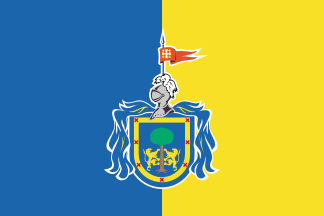 |
2:3 |
| by Juan Manuel Gabino Villascán, July 17, 2001. |
From Flag Report 13,
by Jaume Ollé
May 9, 2001
The first news of the existence of a flag in the state of Jalisco came to me through a young Mexican vexilologist who gave me the colours and said to me that the flag could be seen in Guadalajara quite often. Nevertheless, I believe that contradictory news were mixed, on the one hand the existence of a flag project with blue and yellow colours and on the other hand the exhibition of a flag with these colours as local flag of the city of Guadalajara, that apparently was based on the supposed colours of the Kingdom of Nueva Galicia.
Immediately I requested official information to the governor of the State. Later, I contacted an Argentinian vexilologist resident in Mexico, Luis Havas, who talked to Mr. Fernando Navarro, officer of the Center for the Attention of the Matters Addressed to the Governor of the State of Jalisco, who, by chance, had recived my letter addressed to the governor. Mr. Navarro said that he knew nothing about the issue, but he promised to ask the Congress and see if there was any bill in such sense.
Luis Havas then talked to Mrs. Patricia de la Torre, researcher of the Congress of the State of Jalisco, who was in possession of the project about such a flag. It was, at first, a small flag that the businessmen of Jalisco gave to the Governor, of the opposing party PAN (Party colours: blue and white); this one supported the project and passed it to the Congress' Legal Director, Mr. Palomino. There, it remained under consideration, and when it is finished it will be submitted as a bill, and if approved - and over all, if it is 'approved' by the Governance Secretariat (PRI), then it is possible that Mexico will have for the first time a flag for a state. Mrs. de la Torre promised to send all the precedents.
E-mail from María Patricia de la Torre, Congress of the State of Jalisco, received through Luis Havas:
Excuse me for not having answered your letter sooner, I send you my best regards again and I inform you that the project is still under consideration, but the flag was made by Mr. Jorge García Fernández and Mr. Alejandro Fruchier, President and Director, respectivelly, of the Business Council of Jalisco. Their telephone is 013 634 89 34, ext. 207. As you rightly say it is a formidable idea, that is still under consideraiton. Any advance, if 'authorized', will be communicated to you at once. Thanks for your interest, and best wishes'.
On Monday Luis Havas tried to take contact with some of the mentioned people.
On 18 January 1999 it was received the complete information from the government of the State by means of the Center for the Attention of the Matters Addressed to the Governor. (...)
Constitutional Governor Alberto Cardenas Jiménez ordered the sending of the requested information, collected by Fernando Navarro Toriz. (...)
Concerning the new flag Mr. Navarro says:
There exist the project of submitting a bill to the Congress in order to approve an official flag, but it is yet in process of approval by the Governor. The said project shows in its design blue in the half corresponding to the hoist and the other in gold. The division is in vertical and in the center the official coat-of-arms."
The flag actually in use is that in white with the state arms (a variant of the Guadalajara arms
-see above-) in the center. However, as reporter also by Jaume Ollé in Flag Report 13, there is a bill
on the State Flag. According state representatives
and Mr. Palomino (Congress Head Director and the person whom originally sent the proposal
to the Congress in late 1990s), the bill (entitled Ley de la Bandera del Estado Libre
y Soberano de Jalisco) is planned to be discused, in the next few days by the Comisión
de Asuntos Constitucionales (Comission of Constitutional Matters), if approved, then it
shall be passed by the whole State Congress. This last step could take some weeks, but
according Mr. Palomino, by February 2005 may be a final resolution. Thus if passed, Jalisco
shall be the very first Mexican state in adopt, by law, a local flag.
By the way, the desing proposed is as issued in Flag Report 13 but there will
be some changes in the coat of arms.
Juan Manuel Gabino Villascán, December 08, 2004.
Besides the newly-adopted flag, which has no sample so far, and the de facto white flag with the arms on it, lot of flags meant to represent the State of Jalisco could be seen througout the state: hanging from hotels' flagstaffs, flying at official buildings, being used by state athletes, and adorning both official and unofficial events. Those flags are based on the state official coulours: blue and gold, and all but two, presented here, have the state coat of arms with slightly variations. Of course, the "tricolor" flag with the state arms, mostly used abroad, is included as an alternative as well. It is important to remark that all of these flags are unofficial, since this one is the only official one.
by Juan Manuel Gabino Villascán, February 22, 2007.
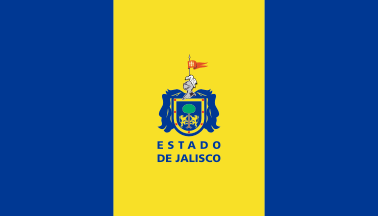
by Juan Manuel Gabino Villascán, February 22, 2007.
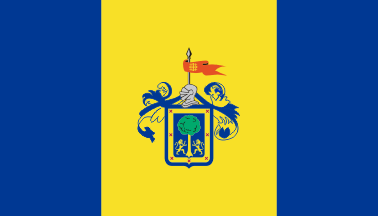
by Juan Manuel Gabino Villascán, February 22, 2007.
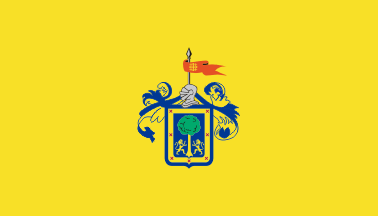
by Juan Manuel Gabino Villascán, February 22, 2007.
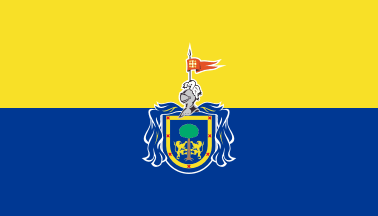
by Juan Manuel Gabino Villascán, February 22, 2007.
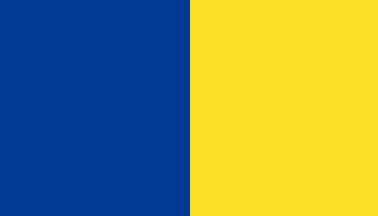
by Juan Manuel Gabino Villascán, February 22, 2007.

by Juan Manuel Gabino Villascán, February 22, 2007.

by Juan Manuel Gabino Villascán, February 22, 2007.
![[Flag of Nueva Galicia]](../images/m/mx-ngali.gif) 2:3
2:3![]()
by Juan Manuel Gabino Villascán, July 17, 2001
The Kingdom of Nueva Galicia, founded about 1532, was a constituent territory of the Viceroyalty of New Spain gaining broad domestic autonomy in 1574, excepting a short period from 1588 to 1591; the Viceroy's authority just might intervene in military and fiscal matters.
Note that Nueva Galicia was not a Viceroyaly, it was named "Kingdom of Nueva Galicia", though it was not governed by a King but by a "governor" who was at the same time president of the Royal Audence of Guadalajara.
The capital, of the so-called Kingdom of Nueva Galicia, was first established at Compostela (currently in the State of Nayarit); then on May 10, 1560, by Royal Cédula, it moved to Guadalajara.
The Kingdom of Nueva Galicia desappeared in 1786 to become the Intendencia of Guadalajara; this allowed the central government to intervener broadly in internal matters. When Mexico achieved independence on 27 September, 1821, and became an Empire, the Intendencia of Guadalajara became the Department of Guadalajara (incorrectly known as "Province of Guadalajara") as a constituent part of the Empire. On June 23, 1823, the Department of Guadalajara, became the "Estado Libre y Soberano de Xalisco"
, a constituent part of the Federal Republic of the United Mexican States.Juan Manuel Gabino Villascán, July 17, 2001
This is the flag of the former Viceroyalty of Nueva Galicia (present-day Jalisco). The interesting thing is that eventhough Méjico (México) achieved its nationhood in 1821, federating into a serperate empire the realms of New Spain, Nueva Galicia, Nueva Vizcaya, Nueva Toledo, etc., this flag is still in use, but now as flag of the city of Guadalajara. This coat of arms was granted to the City of Guadalajara by H.M. King Carlos V in 1542.
Jesus Aceves, 14 Nov 1998.
This is the flag of the former Kingdom of Nueva Galicia that covered most of the current State of Jalisco's territory, including also the current States of Zacatecas, Aguascalientes, and Nayarit. It is said, this flag, with small variations is used as flag of the city of Guadalajara, last capital of Nueva Galicia, and now capital city of the State of Jalisco.
Juan Manuel Gabino Villascán, July 17, 2001.
Anything below this line was not added by the editor of this page.